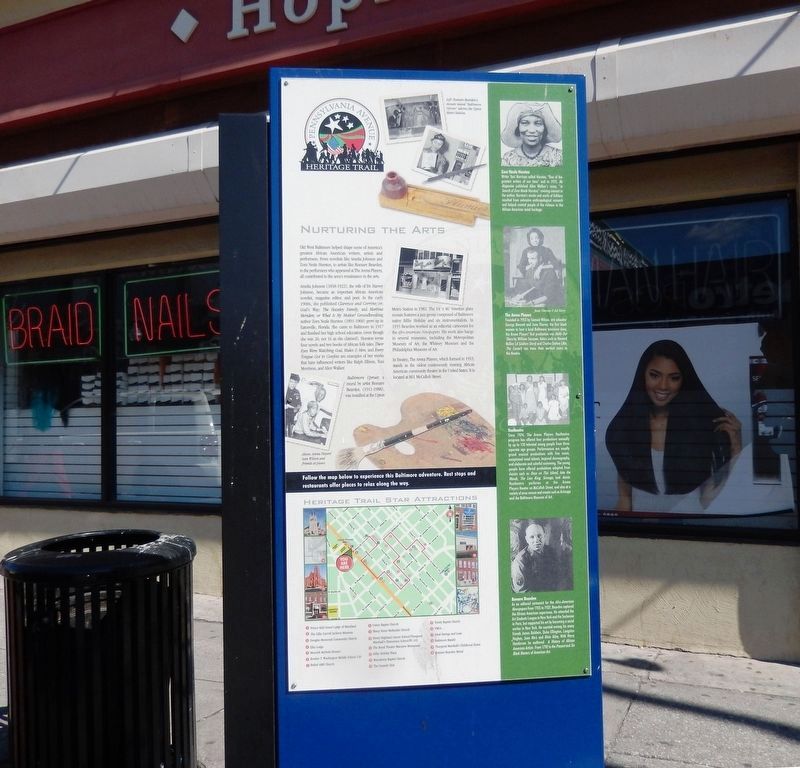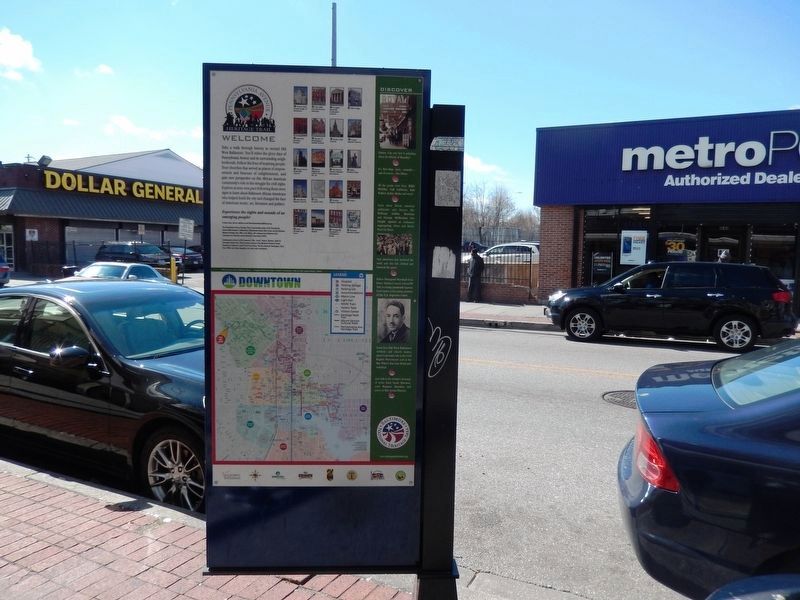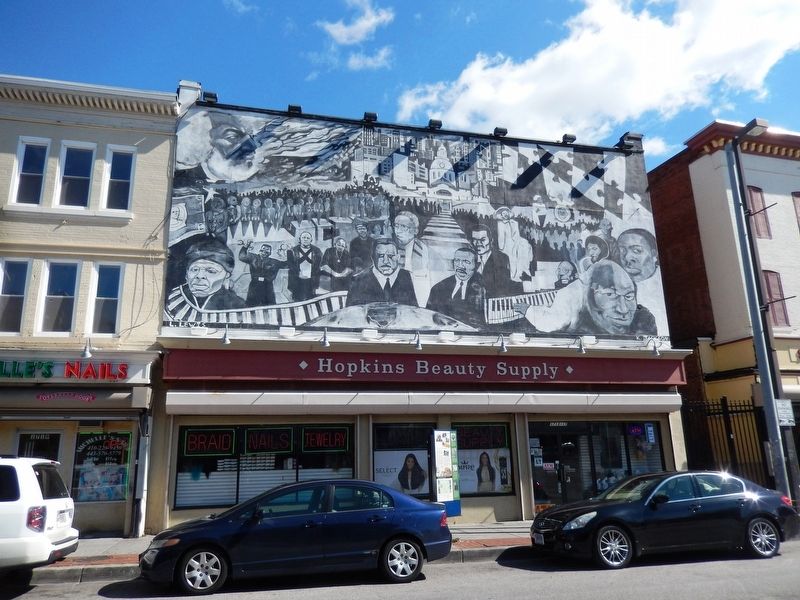Upton in Baltimore, Maryland — The American Northeast (Mid-Atlantic)
Nurturing the Arts
Pennsylvania Avenue Heritage Trail
Amelia Johnson (1858-1922), the wife of Dr. Harvey Johnson, became an important African American novelist, magazine editor, and poet. In the early 1900s, she published Clarence and Corrine; or, God’s Way; or what Is My Motive? Groundbreaking author Zora Neale Hurston (1891-1960) grew up in Eatonville, Florida. She came to Baltimore in 1917 and finished her high school education (even though she was 26, not 16 as she claimed). Hurston wrote four novels and two books of African folk tales, Their Eyes Were Watching God, Mules & Men, and Every Tongue Got to Confess are examples of her works that have influenced writers like Ralph Ellison, Toni Morrison and Alice Walker.
Baltimore Uproar, a mural by artist Romare Bearden (1911-1988), was installed at the Upton Metro Station in 1982. The 14’ x 46’ Venetian glass mosaic features a jazz group composed of Baltimore native Billie Holiday and six instrumentalists. In 1935 Barden worked as an editorial cartoonist for the Afro-American Newspapers. His work also hangs in several museums, including the Metropolitan Museum of Art, the Whitney Museum and the Philadelphia Museum of Art.
In theatre, the Arena Players, which formed in 1953, stands as the oldest continuously running African American community theatre in the United States. It is located at 801 McCulloh Street.
(Inscription beside the image in the upper center)
Left: Romare Bearden’s mosaic mural “Baltimore Uproar” adorns the Upton Metro Station.
(Inscription under the image in the lower left)
Above: Arena Players’ Sam Wilson and friends at piano.
(Inscriptions under the images on the right)
Zora Neale Hurston
Writer Toni Morrison called Hurston, “One of the greatest writers of our time” and in 1975, Ms Magazine published Alice Walker’s essay, “In Search of Zora Neale Hurston,” reviving interest in the author. Hurston’s novels and works of folklore resulted from extensive anthropological research and helped remind people of the richness in the African American racial heritage.
June Thorne & Ed Terry
The Arena Players-Founded in 1953 by Samuel Wilson, arts educator George Bennett and June Thorne, the first black woman to host a local Baltimore television show, the Arena Players’ first production was Hello Out There by William Saroyon. Actors such as Howard Rollins (A Soldiers Story) and Charles Dutton (Roc, The Corner) can trace their earliest years to the theatre.
Youtheatre
Since 1974, The Arena Players Youtheatre program has offered four productions annually by up to 150 talented young people from three separate age groups. Performances are usually grand musical productions with live music, exceptional vocal talents, inspired choreography, and elaborate and colorful costuming. The young people have offered productions adapted from classics such as Once on This Island, Into the Woods, The Lion King, Scrooge, and Annie. Youtheatre performs at the Arena Players Theater on McCulloh Street, and also at a variety of area venues and events such as Artscape and the Baltimore Museum of Art.
Romare Bearden
As an editorial cartoonist for the Afro-American Newspapers from 1935 to 1937, Bearden captured the African American experience. He attended the Art Students League in New York and the Sorbonne in Paris, but supported his art by becoming a social worker in New York. He counted among his many friends James Baldwin, Duke Ellington, Langston Hughes, Joan Muro and Alvin Ailey. With Harry Henderson he authored A History of African American Artists: from 1792 to the Present and Six Black Masters of American Art.
Reverse Side of the Marker
Welcome
Take a walk through history in storied Old
West Baltimore. You’ll relive the glory days of Pennsylvania Avenue and its surrounding neighborhoods. Follow the lives of inspiring people. Tour churches that served as places of empowerment and beacons of enlightenment, and gain new perspective on this African American community’s role in the struggle for civil rights. Explore at your own pace following these story signs to learn about Baltimore African Americans who helped build a city and changed the face of American music, art, literature and politics.
(Inscriptions under the images on the right)
1.Prince Hall Grand Lodge of Maryland
2.The Lillie Carroll Jackson Museum
3.Douglas Memorial Community Church
4.Elks Lodge
5.Morriah Keyhole Houses
6.Booker T. Washington Middle School
7.Bethel AME Church
8.Union Baptist Church
9.Sharp Street Methodist Church
10.Henry Highland Garnet School/PS 103
11.The Royal Theatre Marquee Monument
12.Billie Holiday Plaza
13.Macedonia Baptist Church
14.The Comedy Club
15.Trinity Baptist Church
16.YMCA
17.Ideal Savings and Loan
18.Baltimore Masjid
19.Thurgood Marshall’s Childhood Home
20.Romare Bearden Mural.
Discover
(Inscriptions under the images)
*Listen, Can you feel it pulsating down the Street of Royalty?
*It’s bee-bop, jazz, comedy—and of course—the blues.
*All the greats were here. Billie Holiday, Cab Calloway, Fats Waller, Eubie Blake and more!
*Learn about African American politicians and lawyers like William Ashbie Hawkins and George McMechan who fought against an ordinance segregating whites and blacks block by block.
*Visit churches that nurtured the soul, and also fed, clothed and housed the poor.
*Follow Thurgood Marshall from Henry Highland Garnet School/PS 103, to winning landmark Supreme Court cases, to becoming a justice of the U.S. Supreme Court.
*Learn how Old West Baltimore residents and church leaders played a pivotal role in the Civil Rights Movement and in the Buy Where You Can Work jobs campaign.
*And walk in the creative footsteps of writer Zora Neale Hurston, artist Romare Bearden and actors at the Arena Players.
Topics. This historical marker is listed in these topic lists: African Americans • Arts, Letters, Music • Civil Rights. A significant historical year for this entry is 1917.
Location. 39° 18.235′ N, 76° 38.101′ W. Marker is in Baltimore, Maryland. It is in Upton. Marker is on Pennsylvania Avenue. Touch for map. Marker is at or near this postal address: 1713 Pennsylvania Avenue, Baltimore MD 21217, United States of America. Touch for directions.
Other nearby markers. At least 8 other markers are within walking distance of this marker. Diversity in a Segregated Community (within shouting distance of this marker); Take a Stroll Down the Main Street of the African American Experience (within shouting distance of this marker); Thurgood Marshall House (about 400 feet away, measured in a direct line); Community Growth and Faith (about 600 feet away); Buy Where You Can Work Campaign & Higher Education (about 600 feet away); Building Community Organizations (approx. 0.2 miles away); Suffrage Leaders (approx. 0.2 miles away); J. Howard Payne (1887-1960) House (approx. ¼ mile away). Touch for a list and map of all markers in Baltimore.
Credits. This page was last revised on March 16, 2021. It was originally submitted on March 17, 2017, by Don Morfe of Baltimore, Maryland. This page has been viewed 319 times since then and 38 times this year. Last updated on March 16, 2021, by Carl Gordon Moore Jr. of North East, Maryland. Photos: 1, 2, 3. submitted on March 17, 2017, by Don Morfe of Baltimore, Maryland. • Bill Pfingsten was the editor who published this page.


